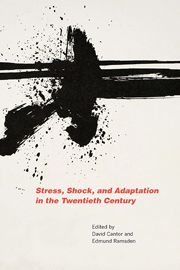Book contents
- Frontmatter
- Contents
- Acknowledgments
- Introduction
- Part One Packaging Stress
- Part Two Trauma and Acute Stress
- 3 Resilience for All by the Year 20–
- 4 From Primitive Fear to Civilized Stress: Sudden Unexpected Death
- Part Three War
- Part Four Work
- Part Five Managing Stress
- Part Six Surveilling Stress
- List of Contributors
- Index
3 - Resilience for All by the Year 20–
from Part Two - Trauma and Acute Stress
Published online by Cambridge University Press: 05 April 2014
- Frontmatter
- Contents
- Acknowledgments
- Introduction
- Part One Packaging Stress
- Part Two Trauma and Acute Stress
- 3 Resilience for All by the Year 20–
- 4 From Primitive Fear to Civilized Stress: Sudden Unexpected Death
- Part Three War
- Part Four Work
- Part Five Managing Stress
- Part Six Surveilling Stress
- List of Contributors
- Index
Summary
The following pages describe the historical transformation of the posttraumatic neurosis into a now-familiar post-traumatic stress disorder. My approach is ethnographic in that I have emphasized transformations in epistemologies—specifically what counts as evidence and what is either taken for granted or altogether ignored. While it is important to follow how these transformations occurred, it is not useful to stick to a unilinear chronological sequence. I begin in 1980, with the publication of DSM-III and the debut of post-traumatic stress disorder (PTSD). PTSD was the first (and remains the only) standardized and obligatory version of a posttraumatic syndrome in the United States. By the 1990s PTSD had become, in effect, a universally accepted version. Beneath the surface of the official list of diagnostic criteria, PTSD is a heterogeneous phenomenon. There are compelling reasons to conclude that PTSD's heterogeneity is intrinsic to its logic, and it is only this logic that distinguishes PTSD from other disorders. Moreover, PTSD's heterogeneity is intractable: it is generally impossible to tell the subtypes apart. This is an important problem, with clinical, forensic, social, and political implications. I argue that scientific discourse on physiological stress provides researchers with possible solutions, a way of circumventing the traumatic memories believed to drive the posttraumatic syndrome. But this conception of stress, intended to stabilize and homogenize the posttraumatic syndrome, is itself polymorphic and eventually extended to include populations unimagined in 1980.
- Type
- Chapter
- Information
- Stress, Shock, and Adaptation in the Twentieth Century , pp. 73 - 95Publisher: Boydell & BrewerPrint publication year: 2014

